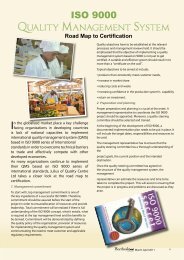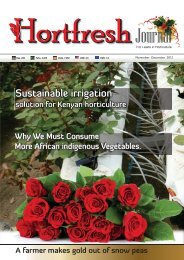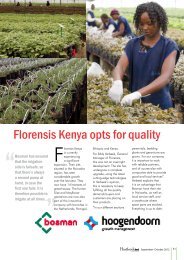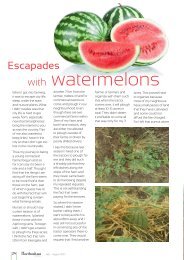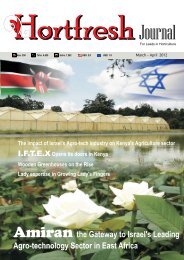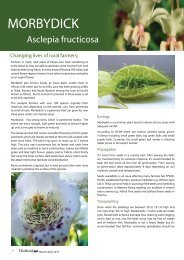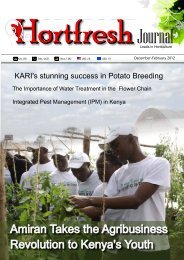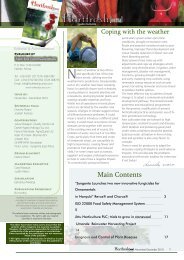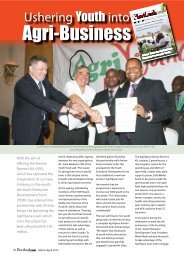curb-postharvest-los.. - Hortfresh Journal
curb-postharvest-los.. - Hortfresh Journal
curb-postharvest-los.. - Hortfresh Journal
Create successful ePaper yourself
Turn your PDF publications into a flip-book with our unique Google optimized e-Paper software.
For leads in Horticulture<br />
Curb Postharvest Losses to<br />
Overcome Population Food<br />
Imbalance<br />
Article by Dr. Arnold M. Opiyo Senior Lecturer in Horticulture Dept. of Crops, Horticulture & Soils - Egerton University<br />
After months<br />
working in the<br />
fields, farmers have<br />
bountiful harvests<br />
of beautiful fruits<br />
and vegetables; and<br />
want to ensure that<br />
their customers also<br />
enjoy the healthy<br />
harvests.<br />
Unfortunately this is not<br />
always the case as large<br />
volumes of these harvests<br />
are <strong>los</strong>t between the farm<br />
gate and the consumer.<br />
While trying to provide<br />
more nutritious food, we<br />
often neglect prevention of<br />
<strong>los</strong>ses between harvest and<br />
consumption. Global human<br />
population is projected<br />
to increase by 35% to 7.7<br />
billion by 2020; which<br />
creates higher demand for<br />
food. As we try to solve the<br />
problem of population food<br />
imbalance, our focus has<br />
been on two approaches:<br />
n Increasing the food supply<br />
by increasing production<br />
area; and by breeding higher<br />
yielding varieties.<br />
n Advocacy of family<br />
planning so as to limit<br />
population growth.<br />
While focusing on the<br />
above two approaches, a<br />
3rd approach, which might<br />
be the most sustainable<br />
in solving the problem of<br />
population food imbalance is<br />
often ignored.<br />
This is: Reduction in food<br />
<strong>los</strong>ses at all levels where they<br />
may occur (at production,<br />
harvesting and marketing<br />
processes).<br />
Where efforts are made<br />
to reduce <strong>los</strong>ses, it is only<br />
limited to the production<br />
stage; while ignoring those<br />
encountered at harvesting<br />
and marketing. Although<br />
some progress has been<br />
recorded in increasing<br />
yields and productivity, it<br />
is important to note that<br />
it (increase in yield and<br />
productivity) significantly<br />
falls short of the increase in<br />
world population and the<br />
nutritional requirements.<br />
POSTHARVEST LOSSES:<br />
Postharvest commences<br />
the moment the plant/plant<br />
organ is separated from<br />
the mother plant or growth<br />
medium; and ends when the<br />
food enters into the process<br />
of being prepared for final<br />
consumption. The problem<br />
of <strong>postharvest</strong> <strong>los</strong>ses is a<br />
major stumbling block in<br />
achieving sustainable food<br />
and nutritional security.<br />
These <strong>los</strong>ses vary greatly<br />
among commodities and<br />
production areas and<br />
seasons; and might occur<br />
at any point along the<br />
<strong>postharvest</strong> chain; i.e. at<br />
harvesting, during packing,<br />
transportation, in both<br />
wholesale and retail markets<br />
and in case of delay at<br />
different points between<br />
harvest and consumption.<br />
Such <strong>los</strong>ses are much higher<br />
in fruits and vegetables.<br />
Postharvest <strong>los</strong>ses reduce<br />
farmers’ incomes in addition<br />
to affecting food supply.<br />
It is not enough just to<br />
18 May-June 2012
produce more food of high<br />
quality. This food must be<br />
availed to the consumer<br />
without <strong>los</strong>s in quantity and<br />
quality along the <strong>postharvest</strong><br />
chain. Not only does physical<br />
<strong>los</strong>s in quantity occur,<br />
but there are also highly<br />
significant <strong>los</strong>ses in essential<br />
nutrients (vitamins and<br />
minerals) and overall quality.<br />
The problem is universal,<br />
affecting both developed<br />
and developing countries;<br />
though the magnitude<br />
and prevalence is higher<br />
in developing countries.<br />
Crop <strong>postharvest</strong> <strong>los</strong>ses in<br />
developing countries are<br />
believed to be between<br />
30 – 40%. These <strong>los</strong>ses are<br />
due to spoilage, waste etc.<br />
With respect to fresh fruits<br />
and vegetables, <strong>postharvest</strong><br />
<strong>los</strong>ses are estimated at<br />
5 – 25% and 20 – 50% in<br />
developed and developing<br />
countries respectively.<br />
Generally, approximately one<br />
third of the total worldwide<br />
horticultural production is<br />
never consumed by humans!<br />
<strong>postharvest</strong> chain. By<br />
minimizing rough handling,<br />
removing damaged<br />
and diseased produce<br />
together with temperature<br />
management, it will be<br />
possible to considerably<br />
reduce storage <strong>los</strong>ses and<br />
maintain product quality.<br />
Postharvest food <strong>los</strong>s<br />
experienced in Africa is of<br />
a higher magnitude. This is<br />
partly because of limited use<br />
of <strong>los</strong>s-saving <strong>postharvest</strong><br />
handling technologies<br />
as well as limited market<br />
opportunities for the millions<br />
of small-scale farmers.<br />
CURBING POSTHARVEST<br />
LOSSES:<br />
Increasing food availability<br />
to the growing world<br />
population can be achieved<br />
through reduction of<br />
<strong>postharvest</strong> <strong>los</strong>ses. By so<br />
doing, the production area<br />
needed will be reduced and<br />
natural resources conserved.<br />
Appropriate approaches for<br />
reducing <strong>postharvest</strong> <strong>los</strong>ses<br />
include:<br />
(<strong>postharvest</strong> <strong>los</strong>ses). Despite<br />
this fact being widely<br />
acknowledged, less than<br />
5% funding of agricultural<br />
research and extension<br />
programs worldwide is<br />
devoted to <strong>postharvest</strong><br />
handling activities research. If<br />
we are to achieve a significant<br />
reduction in <strong>postharvest</strong><br />
<strong>los</strong>ses of horticultural<br />
perishables, then this<br />
situation must change.<br />
Increasing yield and<br />
productivity alone without<br />
reducing <strong>postharvest</strong><br />
<strong>los</strong>ses will not adequately<br />
address the problem of food<br />
and nutritional security.<br />
There’s need to enhance<br />
Postharvest Technology<br />
training and research.<br />
Postharvest technology is<br />
important in that it has the<br />
capacity of meeting the food<br />
needs of the growing world<br />
population. This is because<br />
<strong>postharvest</strong> technology<br />
can eliminate avoidable<br />
food <strong>los</strong>ses; thereby<br />
availing nutritive food by<br />
proper processing, storage,<br />
packaging, transport and<br />
marketing. Hence, reducing<br />
<strong>postharvest</strong> <strong>los</strong>ses is a<br />
reasonable and economically<br />
viable approach in the global<br />
fight against population food<br />
imbalance.<br />
BIBLIOGRAPHY:<br />
1. Kader, A A. and Rolle,<br />
R S. (2004). The role of<br />
post-harvest management<br />
in assuring the quality<br />
and safety of horticultural<br />
produce. FAO Agricultural<br />
services bulletin 152.<br />
2. Kitinoja, L. and Kader,<br />
A A. (2002). Small-scale<br />
Postharvest handling<br />
practices: A manual for<br />
horticultural crops (4th<br />
Edition). University of<br />
California, Davis. Postharvest<br />
technology research and<br />
information center.<br />
3. Kitinoja, L., Saran, S., Roy,<br />
S K and Kader, A A. (2011).<br />
Post-harvest technology<br />
for developing countries:<br />
Challenges and opportunities<br />
in research, outreach and<br />
advocacy. <strong>Journal</strong> of Science<br />
Food and Agriculture; 91:<br />
597 – 603.<br />
4. Opara, U L. (2010). High<br />
incidence of <strong>postharvest</strong> food<br />
<strong>los</strong>ses is worsening global<br />
food and nutrition security.<br />
International <strong>Journal</strong> of<br />
Postharvest Technology and<br />
Innovation; Vol. 2 No. 1: 1 – 3.<br />
MAJOR CAUSES OF<br />
POSTHARVEST LOSSES:<br />
• Using genotypes having<br />
longer <strong>postharvest</strong> life;<br />
The major causes of<br />
<strong>postharvest</strong> <strong>los</strong>ses (physical<br />
and quality) in Kenya are<br />
rough handling, poor quality<br />
packaging material and<br />
inadequate cooling and<br />
temperature management.<br />
The problem is further<br />
compounded by lack of<br />
sorting to remove damaged<br />
or defect produce before<br />
storage. In addition, most<br />
stakeholders generally lack<br />
education on appropriate<br />
<strong>postharvest</strong> handling<br />
techniques along the<br />
• Adoption of integrated crop<br />
management (ICM) systems<br />
and good agricultural<br />
practices (GAP) that enhance<br />
good keeping quality; and<br />
• Application of appropriate<br />
<strong>postharvest</strong> handling<br />
practices with an aim of<br />
maintaining the quality of<br />
fresh fruits and vegetables.<br />
It is more sustainable to<br />
minimize <strong>postharvest</strong> <strong>los</strong>ses<br />
of already produced food<br />
than to increase production<br />
to compensate for these<br />
For leads in Horticulture<br />
May-June 2012<br />
19



